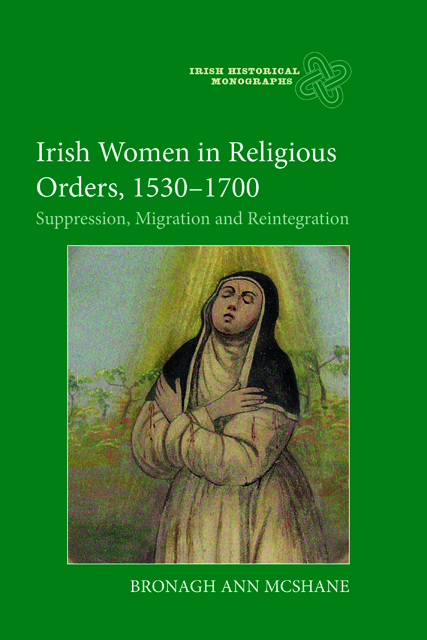6 - Cromwell and the cloister: female religious and the impact of the Cromwellian campaigns, 1649–60
Published online by Cambridge University Press: 17 December 2022
Summary
The Cromwellian campaigns (1649–53) changed irrevocably the political, social, and economic landscape of Ireland. Beginning with the seizure of Drogheda in County Louth in September 1649, and culminating with the capitulation of Galway in May 1652, the period witnessed the military conquest of Ireland by parliamentarian forces and brought to an end the pre-eminence of the Catholic Confederate state. The campaigns resulted in a calamitous loss of life and the destruction of much of the island’s economy and infrastructure. In the four years following the arrival of the parliamentarian army, a combination of warfare, famine, and disease meant that the island underwent a ‘demographic catastrophe’. Micheál Ó Siochrú estimates that mortality rates in Ireland during the period were in the region of 20 per cent (compared to an estimated 3 per cent population loss in England during the civil wars of the 1640s). The subsequent land settlement (1652) resulted in a revolution in landholding among Catholic propertied classes who confronted mass confiscation of their estates and large-scale transportation to the west of Ireland (and, in some cases, the West Indies). The ultimate result was a marked contraction in the fortunes of the Irish Catholic landed elite. Prior to the Cromwellian campaigns, Catholics not only constituted the great majority of the population but owned the greater part of the land in the kingdom, while a Catholic civic patriciate largely dominated most of the municipal life of the island. The Cromwellian land confiscations fundamentally altered the economic and social bases of Catholic power and influence.
The Cromwellian military campaigns and concomitant land confiscations were to have major long-term repercussions for the operation of the Catholic Church and its personnel. Tadhg Ó hAnnracháin contends that the campaigns represented ‘the most ferocious period of persecution of the Catholic church’ in Ireland during the early modern period. The initial tone was set at Drogheda in 1649 when several friars were, as Cromwell himself admitted, ‘knocked on the head promiscuously’. In the early years of the war, male secular and religious clergy, including three bishops, were executed summarily on capture. But less well known is the fact that female religious too were victims of violent deaths (albeit to a lesser extent than their male counterparts).
- Type
- Chapter
- Information
- Irish Women in Religious Orders, 1530-1700Suppression, Migration and Reintegration, pp. 200 - 224Publisher: Boydell & BrewerPrint publication year: 2022



